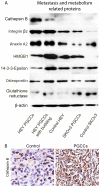iTRAQ-based proteomic analysis of polyploid giant cancer cells and budding progeny cells reveals several distinct pathways for ovarian cancer development
- PMID: 24348907
- PMCID: PMC3858113
- DOI: 10.1371/journal.pone.0080120
iTRAQ-based proteomic analysis of polyploid giant cancer cells and budding progeny cells reveals several distinct pathways for ovarian cancer development
Abstract
Polyploid giant cancer cells (PGCCs) are a morphologically distinct subgroup of human tumor cells with increased nuclear size or multiple nuclei, but they are generally considered unimportant because they are presumed to be nondividing and thus nonviable. We have recently shown that these large cancer cells are not only viable but also can divide asymmetrically and yield progeny cancer cells with cancer stem-like properties via budding division. To further understand the molecular events involved in the regulation of PGCCs and the generation of their progeny cancer cells, we comparatively analyzed the proteomic profiles of PGCCs, PGCCs with budding daughter cells, and regular control cancer cells from the HEY and SKOv3 human ovarian cancer cell lines with and without CoCl2. We used a high-throughput iTRAQ-based proteomic methodology coupled with liquid chromatography-electrospray ionization tandem mass spectroscopy to determine the differentiated regulated proteins. We performed Western blotting and immunohistochemical analyses to validate the differences in the expression patterns of a variety of proteins between PGCCs or budding PGCCs and regular cancer cells identified by iTRAQ approach and also a selected group of proteins from the literature. The differentially regulated proteins included proteins involved in response to hypoxia, stem cell generation, chromatin remodeling, cell-cycle regulation, and invasion and metastasis. In particular, we found that HIF-1alpha and its known target STC1 are upregulated in PGCCs. In addition, we found that a panel of stem cell-regulating factors and epithelial-to-mesenchymal transition regulatory transcription factors were upregulated in budding PGCCs, whereas expression of the histone 1 family of nucleosomal linker proteins was consistently lower in PGCCs than in control cells. Thus, proteomic expression patterns provide valuable insight into the underlying mechanisms of PGCC formation and the relationship between PGCCs and cancer stem cells in patients with ovarian cancers.
Conflict of interest statement
Figures





References
Publication types
MeSH terms
Substances
Grants and funding
LinkOut - more resources
Full Text Sources
Other Literature Sources
Medical

